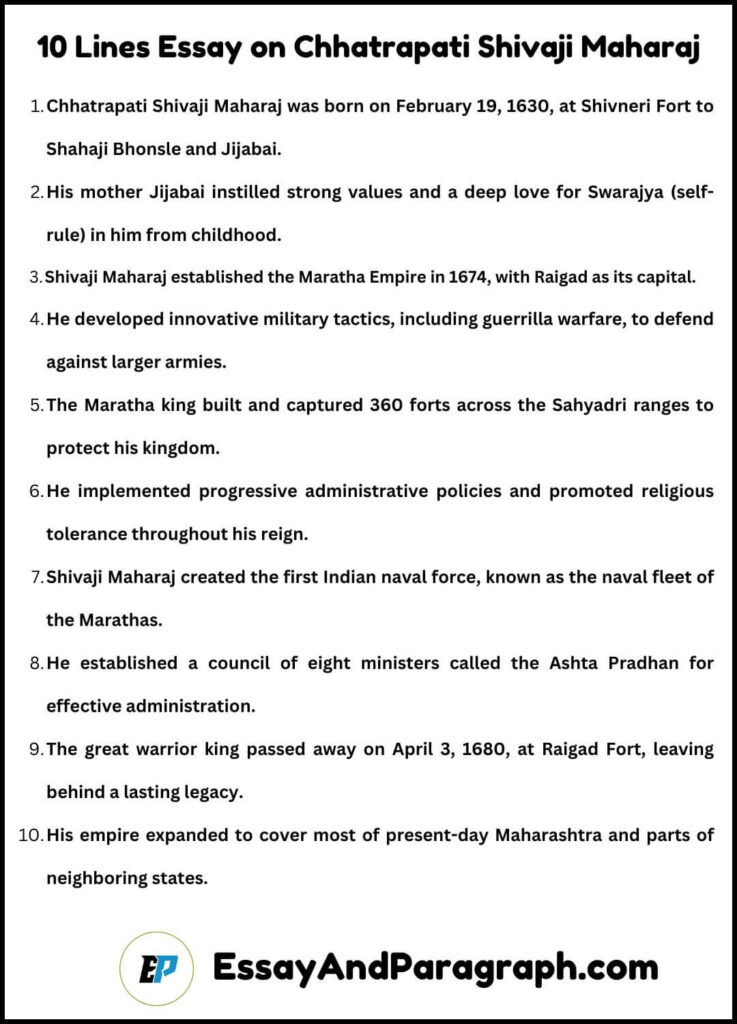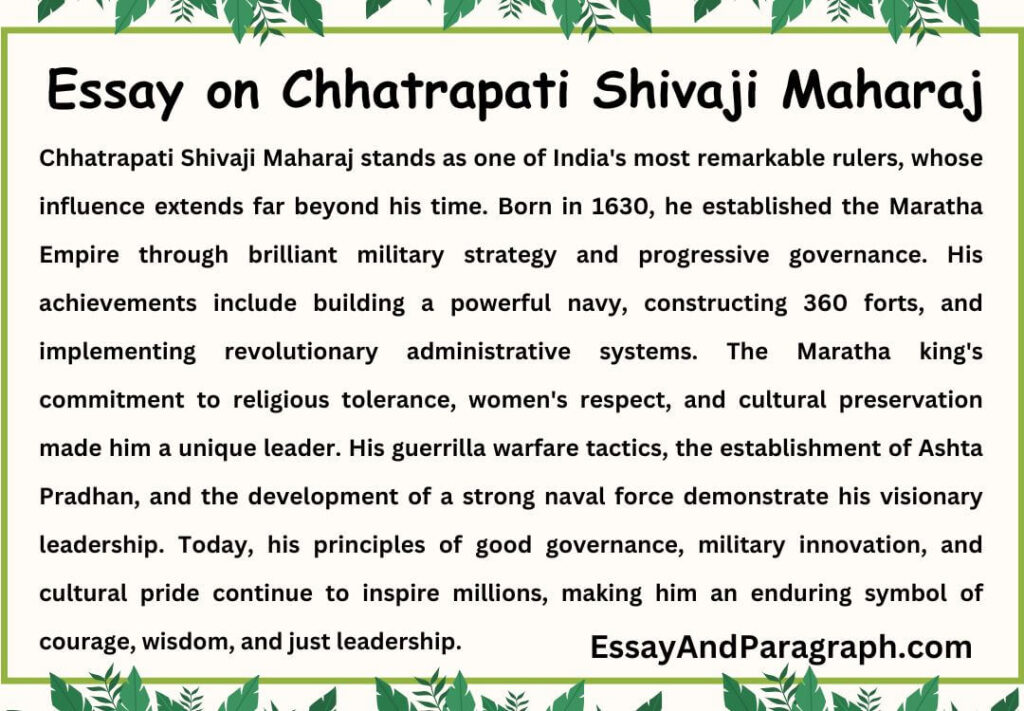Have you ever heard of a warrior king who not only built an empire but also inspired generations with his courage and leadership? Chhatrapati Shivaji Maharaj, the legendary Maratha warrior, established the Maratha Empire in the 17th century through his exceptional military prowess and administrative skills. His life story is a testament to bravery, wisdom, and unwavering dedication to his people and homeland. In this comprehensive guide, we’ll explore the remarkable journey of Shivaji Maharaj, whose legacy continues to inspire millions today.
10 Lines Essay on Chhatrapati Shivaji Maharaj
- Chhatrapati Shivaji Maharaj was born on February 19, 1630, at Shivneri Fort to Shahaji Bhonsle and Jijabai.
- His mother Jijabai instilled strong values and a deep love for Swarajya (self-rule) in him from childhood.
- Shivaji Maharaj established the Maratha Empire in 1674, with Raigad as its capital.
- He developed innovative military tactics, including guerrilla warfare, to defend against larger armies.
- The Maratha king built and captured 360 forts across the Sahyadri ranges to protect his kingdom.
- He implemented progressive administrative policies and promoted religious tolerance throughout his reign.
- Shivaji Maharaj created the first Indian naval force, known as the naval fleet of the Marathas.
- He established a council of eight ministers called the Ashta Pradhan for effective administration.
- The great warrior king passed away on April 3, 1680, at Raigad Fort, leaving behind a lasting legacy.
- His empire expanded to cover most of present-day Maharashtra and parts of neighboring states.

Short Essay on Chhatrapati Shivaji Maharaj
Chhatrapati Shivaji Maharaj emerged as a beacon of hope during a time when much of India was under Mughal rule. Born into the Bhonsle family, he received his early education and military training under the guidance of Dadoji Konddev. His mother Jijabai’s stories of ancient Indian heroes and Hindu scriptures shaped his character and vision for an independent kingdom.
At a young age of 16, Shivaji Maharaj began building his army and captured his first fort, Torna. His military genius showed in his innovative warfare techniques, especially in the mountainous Deccan region. He established a disciplined army and introduced military reforms that included regular payment for soldiers, training in guerrilla warfare, and the use of local terrain to tactical advantage.
The Maratha warrior’s administrative skills were equally impressive. He introduced the concept of Chauth and Sardeshmukhi – taxes that helped build a strong economy. His navy protected the Konkan coastline from foreign powers, making him the first Indian ruler to recognize the importance of naval power. Under his leadership, the Maratha Empire became known for its fair justice system, religious tolerance, and promotion of Marathi language and culture.
Long Essay on Chhatrapati Shivaji Maharaj
Chhatrapati Shivaji Maharaj’s life and achievements represent a golden chapter in Indian history. Born during a period of political turmoil, he grew up with a strong sense of purpose and determination to establish Hindavi Swarajya (Indian self-rule). The foundations of his character were laid by his mother Jijabai’s teachings and the guidance of his mentor Dadoji Konddev.
As a young ruler, Shivaji Maharaj demonstrated exceptional military and diplomatic skills. His conquest began with the capture of Torna Fort at age 16, followed by Raigad, which later became his capital. He developed a unique military system that included infantry, cavalry, and naval forces. His army was known for its disciplined guerrilla warfare tactics, which allowed them to successfully combat larger Mughal forces.
The administrative framework established by Shivaji Maharaj was revolutionary for its time. He divided his kingdom into three main departments: civil, military, and religious. The Ashta Pradhan (council of eight ministers) helped him manage state affairs efficiently. He implemented a fair taxation system, promoted agriculture, and established a strong judicial system that treated all citizens equally regardless of their religion or social status.
Shivaji Maharaj’s naval achievements were particularly noteworthy. He built numerous sea forts and developed a strong navy that protected the western coastline from Portuguese, British, and Siddi invasions. His naval force consisted of 400 ships of various sizes, making the Marathas a formidable maritime power.
Under Shivaji Maharaj’s leadership, the Maratha Empire fostered cultural growth and religious harmony. He respected all religions and protected places of worship, earning the loyalty of subjects across faiths. His coronation as Chhatrapati in 1674 at Raigad Fort marked the establishment of a sovereign Hindu kingdom after centuries of foreign rule.
The Maratha king’s personal character was marked by courage, wisdom, and respect for women. Historical accounts mention his strict code of conduct regarding the treatment of women, even those from enemy territories. His encounters with Afzal Khan, escape from Agra, and the battle of Pratapgad are legendary examples of his tactical brilliance and personal valor.
FAQs about Essay on Chhatrapati Shivaji Maharaj
What was Chhatrapati Shivaji Maharaj’s early life like?
Shivaji Maharaj was born at Shivneri Fort in 1630. His early years were shaped by his mother Jijabai’s spiritual and cultural teachings. He received military training from Dadoji Konddev and learned statecraft, horseback riding, and weaponry. Growing up in the Pune region, he developed a deep understanding of the Deccan terrain, which later proved crucial in his military campaigns. By age 16, he had gathered a loyal band of followers called Mavale troops from the Maval region of Pune.
How did Shivaji Maharaj build the Maratha Empire?
The Maratha Empire was built through a combination of military conquest, diplomatic alliances, and administrative reforms. Starting with the capture of Torna Fort in 1646, Shivaji Maharaj systematically expanded his territory. He used guerrilla warfare tactics, including rapid surprise attacks and strategic retreats. The empire eventually covered most of present-day Maharashtra and parts of Karnataka, Gujarat, and Madhya Pradesh. His innovative military system included a standing army, a naval fleet, and a network of spies.
What were the major reforms introduced by Shivaji Maharaj?
Shivaji Maharaj introduced numerous administrative and military reforms. He established the Ashta Pradhan (council of eight ministers), implemented a fair taxation system, and developed a robust civil administration. He standardized military ranks, introduced regular pay for soldiers, and established a navy. His administrative system was known for its efficiency, justice, and religious tolerance. He also promoted the use of Marathi language in administration and encouraged arts and culture.
How did Shivaji Maharaj’s navy contribute to his success?
Shivaji Maharaj created India’s first organized naval force, consisting of approximately 400 ships of various sizes. The navy protected the 720 km Konkan coastline from foreign invasions and secured maritime trade routes. He built several sea forts, including Sindhudurg, which served as naval bases. The Maratha navy successfully challenged Portuguese, British, and Siddi naval powers, establishing maritime supremacy along the western coast.
What is Shivaji Maharaj’s lasting legacy?
Shivaji Maharaj’s legacy extends far beyond military achievements. He established a model of just and efficient governance, promoted religious tolerance, and protected cultural heritage. His emphasis on self-rule (Swarajya) and cultural pride inspired later independence movements. The administrative systems he established continued long after his time. His life exemplifies leadership, courage, and ethical governance, making him a role model for generations.
How did Shivaji Maharaj treat people of different religions in his kingdom?
Shivaji Maharaj was known for his religious tolerance and respect for all faiths. He protected mosques and Islamic holy places, employed Muslims in high positions, and respected their religious practices. His army included soldiers from various religions, and his administration treated all subjects equally regardless of their faith. He even provided land grants to both Hindu temples and Muslim dargahs, setting an example of secular governance.
Top 5 Quotes on Chhatrapati Shivaji Maharaj
- “Freedom is a boon, which everyone has the right to receive.” – Chhatrapati Shivaji Maharaj
- “When you are doing justice, there is no need to worry about the consequences.” – Chhatrapati Shivaji Maharaj
- “No need to fear, when truth and dharma are on your side.” – Chhatrapati Shivaji Maharaj
- “The son of Mother Earth does not need to sleep on a bed of flowers.” – Chhatrapati Shivaji Maharaj
- “Just as the sun’s rays only fall on the earth’s surface but its heat reaches deeper, the effects of good administration reach far and wide.” – Chhatrapati Shivaji Maharaj

Summary
Chhatrapati Shivaji Maharaj stands as one of India’s most remarkable rulers, whose influence extends far beyond his time. Born in 1630, he established the Maratha Empire through brilliant military strategy and progressive governance. His achievements include building a powerful navy, constructing 360 forts, and implementing revolutionary administrative systems. The Maratha king’s commitment to religious tolerance, women’s respect, and cultural preservation made him a unique leader. His guerrilla warfare tactics, the establishment of Ashta Pradhan, and the development of a strong naval force demonstrate his visionary leadership. Today, his principles of good governance, military innovation, and cultural pride continue to inspire millions, making him an enduring symbol of courage, wisdom, and just leadership.

